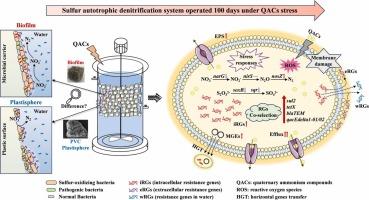不可忽视的环境风险:在暴露于季铵化合物后,硫自养反硝化系统中生物膜和塑性球之间的差异反应
IF 12.2
1区 环境科学与生态学
Q1 ENGINEERING, ENVIRONMENTAL
引用次数: 0
摘要
季铵盐化合物(QACs)和微塑料(MPs)作为新型污染物在污水处理厂(WWTPs)中积累引起了人们的关注。具有独特微生物群落的塑料球也可能是病原体和抗性基因(RGs)的储存库。为此,研究了硫自养反硝化(SAD)系统中3种具有代表性的QACs不同浓度对生物膜和塑性球的影响。100 d时,1 ~ 5 mg/L QACs对系统稳定性影响不大,而15 mg/L QACs则严重降低了系统的微生物活性,抑制效果依次为:苄基烷基二甲基乙基铵化合物;二烷基二甲基铵化合物;烷基三甲基铵化合物。在SAD系统中添加QACs不仅改变了微生物群落的结构和组装,而且在塑料球中诱导细胞内和细胞外RGs的水平高于生物膜。水体中游离RGs丰度虽略有降低,但也可能造成较大的生态风险。被确定为RGs潜在宿主的病原体更倾向于在塑料球中共定位。在SAD系统中,移动遗传因子直接参与了RGs的三组分传递。本研究为生物膜和塑料球在QAC胁迫下的差异反应提供了新的认识,并为污水处理厂的消毒剂和MPs污染控制提供了指导。本文章由计算机程序翻译,如有差异,请以英文原文为准。

Unignorable environmental risks: Insight into differential responses between biofilm and plastisphere in sulfur autotrophic denitrification system upon exposure to quaternary ammonium compounds
Concerns of quaternary ammonium compounds (QACs) and microplastics (MPs) as emerging containments accumulating in wastewater treatment plants (WWTPs) have attracted much attention. Plastisphere with distinctive microbial communities might also be the repository for pathogens and resistance genes (RGs). Thus, the effects of three representative QACs with different concentrations on biofilm and plastisphere were studied in sulfur autotrophic denitrification (SAD) system. Over 100 days, 1-5 mg/L QACs exerted few impacts on system stability, whereas 15 mg/L QACs seriously lowered the microbial activity and the inhibitory effects ranked: benzylalkyldimethylethyl ammonium compound > dialkyldimethyl ammonium compound > alkyltrimethyl ammonium compound. Dosing of QACs in SAD system not only altered the microbial community structure and assembly, but also induced higher levels of intracellular RGs and extracellular RGs in plastisphere than in biofilm. Although the free RGs abundances in water slightly lowered, they might also pose great ecological risks. Pathogens identified as the potential hosts of RGs were more prone to colocalizing in plastisphere. Mobile genetic elements directly contributed to the three-fraction RGs transmission in SAD system. This study offered new insights into the differential responses of biofilm and plastisphere under QAC stress and guided for the disinfectants and MPs pollution containment in WWTPs.
求助全文
通过发布文献求助,成功后即可免费获取论文全文。
去求助
来源期刊

Journal of Hazardous Materials
工程技术-工程:环境
CiteScore
25.40
自引率
5.90%
发文量
3059
审稿时长
58 days
期刊介绍:
The Journal of Hazardous Materials serves as a global platform for promoting cutting-edge research in the field of Environmental Science and Engineering. Our publication features a wide range of articles, including full-length research papers, review articles, and perspectives, with the aim of enhancing our understanding of the dangers and risks associated with various materials concerning public health and the environment. It is important to note that the term "environmental contaminants" refers specifically to substances that pose hazardous effects through contamination, while excluding those that do not have such impacts on the environment or human health. Moreover, we emphasize the distinction between wastes and hazardous materials in order to provide further clarity on the scope of the journal. We have a keen interest in exploring specific compounds and microbial agents that have adverse effects on the environment.
 求助内容:
求助内容: 应助结果提醒方式:
应助结果提醒方式:


